Here it is, the first installment of my “Bedlam in Print” overview of the previous year’s publishing output—specifically those publications of interest to this site. In 2016 those publications, you’ll find, included some film-related books, some experimental fiction and a few interesting novels. With that in mind let’s being with…
Novels
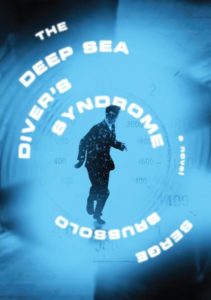 My favorite 2016 published novel was THE DEEP SEA DIVER’S SYNDROME by SERGE BRUSSOLO, a newly translated edition of a 1992 horror/science fiction tale by the “French Stephen King,” put out by Melville House.
My favorite 2016 published novel was THE DEEP SEA DIVER’S SYNDROME by SERGE BRUSSOLO, a newly translated edition of a 1992 horror/science fiction tale by the “French Stephen King,” put out by Melville House.
The title refers to the metaphoric state that befalls one David Sarella, a professional medium who collects dreams. He does this by entering into a trance state and “diving” into the dream realm, wherein he imagines himself a jewel thief stealing valuable contraband, which he takes with him into the waking world. There David’s findings are converted into oddly shaped ectoplasmic objects that in this novel’s future world have therapeutic properties, and are treated as valuable artwork.
Author Serge Brussolo presents this exposition-heavy account in a consistently readable fashion, doling out information in an economic chapter-by-chapter manner. In this way Brussolo makes us privy to his protagonist’s early years, marked by an initial recognition of his unique talents. We also learn of the problems, both physical and psychological, that Peter currently encounters due to his prolonged immersion in the dream world, and Nadia, an alluring product of David’s subconscious whose hold extends far beyond the dream realm.
These various strands are neatly intertwined in a haunting yet satisfying conclusion, in which we’re introduced to yet another facet of the novel’s bizarre reality, one which comes to encompass the mysteries of life, death and beyond.
I also appreciated UGLY by the prolific filmmaker and sometime novelist MICK GARRIS, put out by Cemetery Dance. Running a brisk 86 pages, UGLY is crisply written with noteworthy descriptive skill, being a warped variant on VERTIGO and FRANKENSTEIN whose insights into the lives and mindsets of the Beautiful People ring true, even if that truth is quite (yes) ugly.
The narrator is an altogether vile individual named Terry, a Beverly Hills plastic surgeon responsible for sculpting the faces and bodies of quite a few movie stars. Consumed with appearances, Terry views physical attraction as all-important, and has no patience or respect for anyone who doesn’t possess it. One morning he’s confronted in a coffee shop by Brittany, a horrifically ugly woman who spikes Terry’s coffee with Viagra and rapes him. He’s understandably traumatized, not due to the rape itself so much as the fact that it was committed by such a heinous creature.
The manner in which Terry makes things right is entirely in keeping with his profession and overall world-view: he kidnaps Brittany and straps her to an operating table, aiming to use his surgical skills to recraft her appearance. There are some brutal twists in store, with Garris pointedly ignoring his commercial Hollywood instincts–which decree that a happy, or least moral, ending is a necessity–in a finale that essentially defines uncompromising.
The idea of a satanically endowed rock band isn’t new, but in the WordFire Press published BANSHEES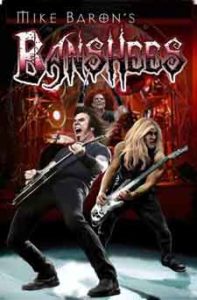 by MIKE BARON (of 2013’s SKORPIO) it assumes a terrifically pulpy grandeur. BANSHEES has a world-spanning scope that incorporates black magic, vampirism, zombies and, perhaps most horrifying of all, an entirely convincing portrayal of the corporate rock scene.
by MIKE BARON (of 2013’s SKORPIO) it assumes a terrifically pulpy grandeur. BANSHEES has a world-spanning scope that incorporates black magic, vampirism, zombies and, perhaps most horrifying of all, an entirely convincing portrayal of the corporate rock scene.
Burned-out rocker Ian St. James is a self-proclaimed “pimple on the ass of pop music.” He’s also the son of Oaian St. James, the late drummer for the notorious heavy metal band the Banshees. While stuck in Prague one night Ian is quite stunned to find that the Banshees are playing a local nightclub–an especially surprising development considering the Banshees’ members all died in a plane crash back in 1975!
As the Banshees’ new incarnation grows increasingly popular many people connected with the band die in horrific fashion. All the while Ian follows the Banshees on their tour across the US, and eventually scores an interview with the band, who confirm what many had long suspected: that the resurrected Banshees are in league with the Big S, who is using them to consolidate his power over humanity.
Mike Baron’s terrifically funky and profane prose, which is quite frank in its descriptions of grue, has been likened to “Quentin Tarantino on paper.” The whole thing is related in short, pointed chapters with a cliffhanger at the end of each, resulting in an absorbing novel with the flow and sensation of a good movie—in fact, BANSHEES may actually be better than a movie.
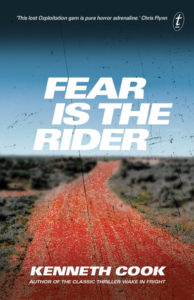 FEAR IS THE RIDER, from Text Publishing, is a newly discovered manuscript by Australia’s late KENNETH COOK. As with most posthumously published fiction, it’s far from perfect; there was clearly a reason this book, which reads like Cook’s legendary debut novel WAKE IN FRIGHT crossed with Steven Spielberg’s DUEL, never saw publication during its author’s lifetime. It is interesting, however, as an example of a horrific chase narrative stripped down to its bare essentials.
FEAR IS THE RIDER, from Text Publishing, is a newly discovered manuscript by Australia’s late KENNETH COOK. As with most posthumously published fiction, it’s far from perfect; there was clearly a reason this book, which reads like Cook’s legendary debut novel WAKE IN FRIGHT crossed with Steven Spielberg’s DUEL, never saw publication during its author’s lifetime. It is interesting, however, as an example of a horrific chase narrative stripped down to its bare essentials.
The setting is the Australian outback, a locale no writer ever described better than Kenneth Cook. John Shaw, an architect, is on a sojourn in a particularly untamed region, where the temperature is beyond sweltering and the surroundings are anything but welcoming. He meets up with Katie, a journalist looking for inspiration for future articles. It’s she who inadvertently attracts the attention of an axe-wielding maniac who may be supernaturally endowed, and who grows bound and determined to wipe John and Katie off the face of the Earth.
Cook succeeds in delivering a gripping and suspenseful account with some genuinely shivery set-pieces, but he clearly never got around to properly fleshing it out. We learn next to nothing about the protagonists or their pursuer outside the fact that they’re good and he’s bad, with all the dialogue being purely expository (sample exchange: “Have you got any matches?” “No.”). I’m all for minimalism in thrillers, but this one is plain undernourished.
Speaking of malnourished: THE SUBSIDIARY by MATIAS CELEDON (Melville House) is a real oddity, a very design-centric, ultra-minimalistic “novel” translated from the Spanish. It consists of 200 pages, each of which contains a single stamped phrase. This is due to the fact that the protagonist is a corporate drone whose job is to stamp documents, and when a catastrophic power outage hits his office the only way he’s able to communicate (it seems) is through his stamper. Hence all the stamped phrases like “The Power is Out,” “She Becomes Frightened” and “They Scrape at the Door with Their Teeth.”
The narrative, such as it is, has the protagonist and his fellow employees acting like the depraved apartment dwellers of J.G. Ballard’s HIGH-RISE; that is to say they quickly lose all their inhibitions in a riot of sex and violence. But then an eventual twist throws all of this into question in its suggestion that the stamp-happy narrator may not be entirely, or even partially, reliable. The result is an interesting but very slight experiment that should take you around ten to twenty minutes to read.
Reprints of Note
THE CADAVER OF GIDEON WYCK by ALEXANDER LAING was originally published back in 1934, and brought back into print in 2016 by Valancourt Books. It’s a real curiosity: a strange, rather morbid mystery filled with bizarre and grotesque elements.
The majority of this tale is told by a medical student looking to solve the murder of one Professor Gideon Wyck. Said killing doesn’t occur until about fifty pages into the novel, the first portion of which is consumed with the living Wyck’s bizarre behavior, in particular a strange malady he appears to have contracted. Further conflict arrives in the form of an amputee patient who claims the not-so-good professor has been siphoning blood from him.
As I stated earlier, the novel has a macabre edge, which is particularly evident in the climax, when we learn exactly what Wyck was up to when he was murdered. I won’t give the “secret” away, but will reveal that it involves an experiment that’s infinitely stranger and more compelling than the details of the killing itself!
Beyond that the novel is penned in a smooth and straightforward manner. Its small town college atmosphere is vividly evoked, with quite a few convincing details. The characterizations are strong, if a tad slight—like innumerable mysteries past and present, it’s the story that takes center stage here, often at the expense of nearly everything else.
CAST A COLD EYE by the late ALAN RYAN, initially published back in 1984, was republished in 2016, once again by Valancourt Books. It’s the best of Ryan’s early books (which include the now-forgotten novels PANTHER, THE KILL and DEAD WHITE) by far: compelling, mysterious and superbly atmospheric. It’s set in rural Ireland, where a Yank writer is working on a book about the potato famine, and discovering that the area is inhabited by some decidedly unquiet spirits.
The protagonist is well drawn, but the setting is the book’s real protagonist, having been rendered with such vividness that after reading the book I almost felt like I’ve been to Ireland. Also impressive is Ryan’s slow, deliberate pace, achieved with a surfeit of gore.
A “quiet” horror story, to be sure, and one that’s ideal for St. Patty’s Day.
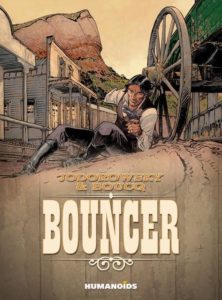 The Euro-comic saga BOUNCER, scripted by ALEJANDRO JODOROWSKY and illustrated by FRANCOIS BOUCQ, was put out by Humanoids in 2016 in a much thicker, more complete package than the previous two part version (subtitled RAISING CAIN) that was published back in ‘04.
The Euro-comic saga BOUNCER, scripted by ALEJANDRO JODOROWSKY and illustrated by FRANCOIS BOUCQ, was put out by Humanoids in 2016 in a much thicker, more complete package than the previous two part version (subtitled RAISING CAIN) that was published back in ‘04.
By traditional Jodorowsky standards, it must be said, BOUNCER is a fairly straightforward western. It’s hard-edged and violent, and relates a more-or-less standard tale of vengeance and frayed family ties. Of course, this being a Jodorowsky product, there are plenty of arrestingly oft-kilter touches, such as the setting: a rocky, cavernous landscape apparently meant to be Arizona or Utah but which actually appears more like the mountains of Tibet.
The narrative involves a kid being taught courage and self-discipline by a sage-like one-armed gunslinger known as Bouncer. The boy is looking to get revenge on the scumbags who’ve murdered his father. Said father is in fact Bouncer’s brother, who lusted after the Eye of Cain, a fabulous emerald, to the point that it consumed his life…
Bottom line: an impressively executed shoot-‘em-up that’s audacious, violent and complex. The artwork of Francois Boucq is breathtaking, easily matching that of Georges Bess, another frequent Jodorowsky partner in graphics, in its bold color and voluminous detail.
Another essential Humanoids reprint was THOUSAND FACES, scripted by PHILIPPE THIRAULT and illustrated by MARC MALES, a French comic that (like BOUNCER) previously appeared in truncated form in the U.S. This new version, thankfully, is far more comprehensive (and features a back cover blurb from yours-truly).
It’s an 1800’s set “weird western” sketched in broad, epic strokes. That epic-ness extends to the artwork, which is often presented in globular wide shots that mimic the view through a fisheye lens.
Through a highly elliptical, flashback-laced narrative we learn how a shape-shifting demon has manifested itself in the body of one Professor Laney, a London based physician. Much of the story is told from the point of view of Laney’s sidekick Quinn, who flees to America after stabbing the demonic professor. Quinn winds up in South Dakota, where he’s taken in by a Sioux tribe after using his medical expertise to save the life of one of their tribesmen. It’s here that Quinn learns of the true nature of his former master, who the Sioux call Thousand Faces.
The setting may be South Dakota but this is very much a European comic. The frankness of the sex and violence attests to this, as does the flashback-happy narrative and overall treatment of the Sioux; the Native Americans of THOUSAND FACES are neither the mindless savages portrayed by old Hollywood movies nor the stoic do-gooders of the newer ones, but a fierce and proud people prone to some extremely bad behavior…
Nonfiction
In the nonfiction sphere we have THE BYE BYE MAN AND OTHER STRANGE-BUT-TRUE TALES by ROBERT DAMON SCHNECK 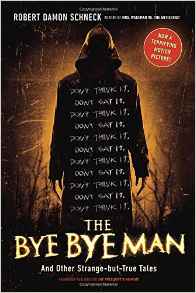 (TarcherPerigee). It follows Schneck’s MRS. WAKEMAN AND THE ANTICHRIST, which related a number of too-strange-for-fiction accounts. Several more such accounts are included here.
(TarcherPerigee). It follows Schneck’s MRS. WAKEMAN AND THE ANTICHRIST, which related a number of too-strange-for-fiction accounts. Several more such accounts are included here.
Among them are “The Devil’s Militia,” which details the seemingly ghostly marauders that terrorized colonial New England back in 1692, and “Bribing the Dead,” which relates the exploits of one Ransford Rogers, a fake sorcerer who in New Jersey of 1788 convinced several deluded folk to hand money over to ghosts who would in turn reveal the whereabouts of buried treasure. Then there’s the title story, which differs from the other entries in that it consists of a first person recollection by a close friend of the author. This account, which has the unpretentious simplicity of a good campfire story, is summed up by its irresistible opening sentence: “At the end of the summer of 1990, three friends living in a small town in Wisconsin carried out an experiment with a Ouija board that brought them into contact with a monster.”
Rounding things out are “The Lost Boys,” about the still-unsolved 1978 disappearance of five young men in Newark, New Jersey; “The President’s Vampire,” about a (supposed) late 19th vampire named James Brown who may have inspired DRACULA; and “A Horror in the Heights,” about an uncanny phantom reportedly seen by many spectators in and around a Baltimore, Maryland housing project in July of 1951.
Is THE BYE BYE MAN as strong overall as the Edgar Award nominated MRS. WAKEMAN AND THE ANTICHRIST? I don’t think so, but it is a mighty diverting book that will provide plenty of food for thought, and not a few authentic chills.
JOE GOULD’S TEETH by JILL LEPORE (Knopf) is a brief account of the inception and possible fate of THE ORAL HISTORY OF OUR TIME, allegedly the longest book ever written. The ORAL HISTORY is—or, perhaps more accurately, was—a manuscript handwritten on hundreds of notebooks by one Joe Gould during the early 1920s through the late 1940s, consisting of voluminous man-on-the-street interviews. Unfortunately that HISTORY is currently MIA, which has led to widespread claims that it never existed in the first place.
In these pages author Jill Lepore argues, persuasively, that this text did in fact exist, and offers a plausible explanation of what became of it. That latter query involves Augusta Savage, a black woman with whom Gould was unhealthily fixated—and with whom he probably entrusted his notebooks. Based on the biographical details Lepore supplies here, it seems that Gould was a loon, and a violent one prone to frequent incarcerations in insane asylums.
Unfortunately the author, who writes for the New Yorker, can’t resist coating this fascinating account with an annoying literary overlay, throwing in much boring detail about her own search for Joe Gould’s book (Lepore’s recollections more often than not entail making appointments with museum and library employees and then being told to wait—scintillating stuff!), and also the business about Gould’s teeth, which has no real bearing on the narrative other to provide a suitably ironic point of focus in the opening and closing chapters.
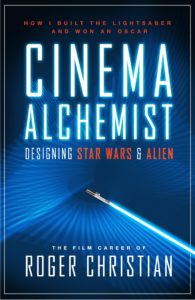 As I stated upfront, there were a number of worthwhile film books published in 2016, starting with CINEMA ALCHEMIST (Titan Books). It’s a memoir by the legendary set decorator turned director ROGER CHRISTIAN about his work on STAR WARS, ALIEN and his self-directed short film BLACK ANGEL.
As I stated upfront, there were a number of worthwhile film books published in 2016, starting with CINEMA ALCHEMIST (Titan Books). It’s a memoir by the legendary set decorator turned director ROGER CHRISTIAN about his work on STAR WARS, ALIEN and his self-directed short film BLACK ANGEL.
Christian’s work as set decorator on STAR WARS was a large part of what made that film the success it was. What Christian did that was so revolutionary was to employ pre-used material, scavenged from masses of discarded airplane parts and other such detritus, in the dressing of the sets, imparting a gritty, lived-in look that was unprecedented in science fiction cinema of the late 1970s.
As one of the few crewmembers on STAR WARS’ calamitous shoot who was unswervingly loyal to George Lucas, Christian doesn’t hesitate to call out the bratty behavior displayed by Lucas’ collaborators. The production of ALIEN was apparently not dissimilar: once again it involved a visionary director, in this case Ridley Scott, fighting against a tight budget and collaborators who didn’t share his vision.
The chapters on BLACK ANGEL are fascinating for different reasons. Here we’re made privy to Christian’s attempts at creating a mythically oriented mini-epic with a non-existent budget, unpredictable weather and a complete lack of directorial experience. Luck, it transpires, played a large part in the film’s success.
Granted, those of you without a rooting interest in STAR WRS, ALIEN or BLACK ANGEL probably won’t be as enthralled by this book as I was. But if by chance you share my enthusiasm for Christian’s achievements then this user-friendly tome is required reading, pure and simple!
For Stanley Kubrick buffs STANLEY KUBRICK AND ME (Arcade Publishing), a memoir by Kubrick’s longtime personal assistant EMILIO 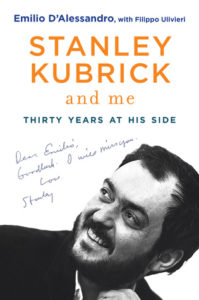 D’ALESSANDRO, can be classified as one of the few truly essential print resources on the great man. As described here, the Italian-bred, London-based Emilio D’Alessandro was a sparsely educated automobile enthusiast when in 1971 was sent by the delivery company he worked for to the home of Stanley Kubrick. D’Alessandro was quickly inducted into Kubrick’s life and business affairs, serving as a driver, handyman and butler. It helped, of course, that D’Allessandro had an inexhaustible work ethic, and so was able to keep up with Kubrick’s labor intensive perfectionism.
D’ALESSANDRO, can be classified as one of the few truly essential print resources on the great man. As described here, the Italian-bred, London-based Emilio D’Alessandro was a sparsely educated automobile enthusiast when in 1971 was sent by the delivery company he worked for to the home of Stanley Kubrick. D’Alessandro was quickly inducted into Kubrick’s life and business affairs, serving as a driver, handyman and butler. It helped, of course, that D’Allessandro had an inexhaustible work ethic, and so was able to keep up with Kubrick’s labor intensive perfectionism.
Juicy tidbits? Sorry, but outside the revelation that Jack Nicholson was as nutty off screen during the filming of THE SHINING as he was onscreen, there aren’t too many. In fact, the book’s major revelation is how sane and kind-hearted Kubrick comes off throughout, a fact that surprised even Kubrick’s cast members, who D’Allessandro was constantly having to reassure before they met their director–with their apprehension inevitably turning to bemused surprise upon finding out that he wasn’t such a terrible guy after all.
This book, like Emilio D’Allessandro himself, is compelling in its own low-key, unassuming manner, and quite moving in the final passages, which detail Kubrick’s untimely demise. The book’s appeal is, aside from its unprecedented portrayal of Stanley Kubrick, in its depiction of a quiet individual whose life was rendered interesting almost in spite of itself.
Looking Forward…
THE DEATH OF FANTOMAS By MARCEL ALLIN and PIERRE SOUVESTRE: Black Coat Press has been announcing this, the first-ever English translation of a pivotal entry in the early-1900s Fantomas series, for years—and now, or at least in June 2017, it looks like it might finally appear!
THE DELICATE DEPENDENCY By MICHAEL TALBOT: I’ve long held that this is one of the greatest vampire novels of our time; about the forthcoming Centipede Press hardcover edition of this essential book I know next to nothing, but am definitely intrigued!
GORILLA IN MY ROOM By JACK KETCHUM: A new short story collection by the great (if agonizingly unprolific) Jack Ketchum! Need I say more?
HELL HOUND By KEN GREENHALL: An upcoming release by the indefatigable Valancourt Books that should be a far bigger deal than it is to most people: the first American edition in over forty years of Ken Greenhall’s criminally neglected mind-roaster about an evil dog in suburban America.
LITTLE HEAVEN By NICK CUTTER: The latest novel by THE TROOP’S Nick Cutter, a western themed horror epic that one reviewer has called “the darkest book I’ve ever read,” looks VERY promising!
THE MAGICAL TWINS By ALEJANDRO JODOROWSKY, GEORGES BESS: A new (to America, that is) graphic novel scripted by the demented Alejandro Jodorowsky that purports to involve (you guessed it!) magically-endowed twins.
NO ESCAPE By R.R. RYAN: In which Ramble House continues its reissuing of the long-unavailable novels of England’s late R.R. Ryan (following the RH editions of THE SUBJUGATED BEAST, FREAK MUSEUM, ECHO OF A CURSE, DEATH OF A SADIST and DEVIL’S SHELTER). Needless to say, I approve!
TAXI DRIVER By PAUL SCHRADER: This Gauntlet Press release promises to be the ultimate print edition of one of greatest screenplays ever written, with scads of extra features (interviews, etc.) that will hopefully justify what is certain to be a highly inflated price tag.
